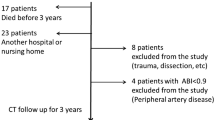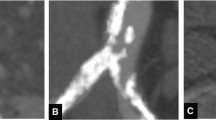Abstract
Purpose
To assess the relationship between the systolic sac pressure index (SPI) and the presence of endoleaks 12 months after endovascular abdominal aortic aneurysm repair (EVAR).
Materials and Methods
We performed a single-center prospective trial of consecutively treated patients. SPI (calculated as systolic sac pressure/systolic aortic pressure) was measured by catheterization immediately after EVAR. Contrast-enhanced computed tomography was scheduled 12 months after EVAR to detect possible endoleaks.
Results
Data were available for 34 patients who underwent EVAR for an AAA. Persisting type II endoleak was found in 8 patients (endoleak-positive group) but not in the other 26 patients (endoleak-negative group). The mean ± standard deviation SPI was significantly greater in the endoleak-positive group than in the endoleak-negative group (0.692 ± 0.048 vs. 0.505 ± 0.081, respectively; P = .001). Receiver-operating characteristic curve analysis revealed that an SPI of 0.638 was the optimum cutoff value for predicting a persistent endoleak at 12 months with high accuracy (0.971; 33/34), sensitivity (1.00), and specificity (0.962) values. The mean change in AAA diameter was −4.28 ± 5.03 mm and 2.22 ± 4.54 mm in patients with SPI of <0.638 or ≥0.638, respectively (P = .002).
Conclusion
Patients with an SPI of ≥0.638 immediately after EVAR were more likely to have a persistent type II endoleak at 12 months with an accuracy of 0.971, and showed increases in aneurysm sac diameter compared with patients with an SPI of <0.638.





Similar content being viewed by others
Abbreviations
- AAA:
-
Abdominal aortic aneurysm
- CT:
-
Computed tomography
- EVAR:
-
Endovascular abdominal aortic repair
- ROC:
-
Receiver-operating characteristic
- SD:
-
Standard deviation
- SPI:
-
Sac pressure index (systolic sac pressure/systolic aortic pressure)
References
EVAR trial participants. Endovascular aneurysm repair and outcome in patients unfit for open repair of abdominal aortic aneurysm (EVAR trial 2): randomised controlled trial. Lancet. 2005;365(9478):2187–92.
Prinssen M, Verhoeven EL, Buth J, Cuypers PW, van Sambeek MR, Balm R, et al. Dutch randomized endovascular aneurysm management (DREAM) trial group. A randomized trial comparing conventional and endovascular repair of abdominal aortic aneurysms. N Engl J Med. 2004;351(16):1607–18.
Haider SE, Najjar SF, Cho JS, Rhee RY, Eskandari MK, Matsumura JS, et al. Sac behavior after aneurysm treatment with the Gore Excluder low-permeability aortic endoprosthesis: 12-month comparison to the original Excluder device. J Vasc Surg. 2006;44(4):694–700.
Hinchliffe RJ, Goldberg J, Macsweeney ST, Zenith Users Group. A UK multi-centre experience with a second-generation endovascular stent-graft: results from the Zenith Users Group. Eur J Endovasc Surg. 2004;27(1):51–5.
Laheij RJ, Buth J, Harris PL, Moll FL, Stelter WJ, Verhoeven EL. Need for secondary interventions after endovascular repair of abdominal aortic aneurysms (Intermediate-term follow-up results of a European collaborative registry (EUROSTAR)). Br J Surg. 2000;87(12):1666–73.
Gelfand DV, White GH, Wilson SE. Clinical significance of type II endoleak after endovascular repair of abdominal aortic aneurysm. Ann Vasc Surg. 2006;20(1):69–74.
Jones JE, Atkins MD, Brewster DC, Chumg TK, Kwolek CJ, LaMuraglia GM, et al. Persistent type 2 endoleak after endovascular repair of abdominal aortic aneurysm is associated with adverse late outcomes. J Vasc Surg. 2007;46(1):1–8.
Zarins CK, Bloch DA, Crabtree T, Matsumoto AH, White RA, Fogarty TJ. Aneurysm enlargement following endovascular aneurysm repair: AneuRx clinical trial. J Vasc Surg. 2004;39(1):109–17.
Nakai M, Sato H, Sato M, Tanba Y, Noda Y, Ikoma A, et al. Clinical significance of endoleaks characterized by computed tomography during aortography performed immediately after endovascular abdominal aortic aneurysm repair: prediction of persistent endoleak. Jpn J Radiol. 2013;31(1):16–23.
Schlösser FJ, Gusberg RJ, Dardik A, Lin PH, Verhagen HJ, Moll FL, et al. Aneurysm rupture after EVAR: can the ultimate failure be predicted? Eur J Vasc Endovasc Surg. 2009;37(1):15–22.
Nakai M, Sato M, Sato H, Sakaguchi H, Tanaka F, Ikoma A, et al. Midterm results of endovascular abdominal aortic aneurysm repair: comparison of instruction-for-use (IFU) cases and non-IFU cases. Jpn J Radiol. 2013;31(9):585–92.
Stanley BM, Semmens JB, Mai Q, Goodman MA, Hartley DE, Wilkinson C, et al. Evaluation of patient selection guidelines for endoluminal AAA repair with the Zenith Stent-Graft: the Australasian experience. J Endovasc Ther. 2001;8(5):457–64.
Greenberg RK. Abdominal aortic endografting: fixation and sealing. J Am Coll Surg. 2002;194(1 Suppl):S79–87.
Ishibashi H, Ishiguchi T, Ohta T, Sugimoto I, Iwata H, Yamada T, et al. Intraoperative sac pressure measurement during endovascular abdominal aortic aneurysm repair. Cardiovasc Interv Radiol. 2010;33(5):939–42.
Golzarian J, Dussaussois L, Abada HT, Gevenois PA, Van Gansbeke D, Ferreira J, et al. Helical CT of aorta after endoluminal stent-graft therapy: value of biphasic acquisition. AJR Am J Roentgenol. 1998;171(2):329–31.
Gorich J, Rilinger N, Sokiranski R, Soldner J, Kaiser W, Kramer S, et al. Endoleaks after endovascular repair of aortic aneurysm: are they predictable? -initial results. Radiology. 2001;218(2):477–80.
Ohki T, Ouriel K, Silveira PG, Katzen B, White R, Criado F, et al. Initial results of wireless pressure sensing for endovascular aneurysm repair: the APEX trial-acute pressure measurement to confirm aneurysm sac exclusion. J Vasc Surg. 2007;45(2):236–42.
Ellozy SH, Carroccio A, Lookstein RA, Jacobs TS, Addis MD, Teodorescu VJ, et al. Abdominal aortic aneurysm sac shrinkage after endovascular aneurysm repair: correlation with chronic sac pressure measurement. J Vasc Surg. 2006;43(1):2–7.
Dias NV, Ivancev K, Resch TA, Malina M, Sonesson B. Endoleaks after endovascular aneurysm repair lead to nonuniform intra-aneurysm sac pressure. J Vasc Surg. 2007;46(2):197–203.
Gawenda M, Hechenkamp J, Zaehringger M, Brunkwall J. Intraaneurysm sac pressure–the Holy grail of endoluminal grafting of AAA. Eur J Endovasc Surg. 2002;24(2):139–45.
Veith FJ, Baum RA, Ohki T, Amor M, Adiseshiah M, Blankensteijn JD, et al. Nature and significance of endoleaks and endotension: summary of opinions expressed at an international conference. J Vasc Surg. 2002;35(5):1029–35.
Author information
Authors and Affiliations
Corresponding author
Ethics declarations
Conflict of Interest
All authors have no conflicts of interest to declare. The authors have no personal financial or institutional interest in any of the drugs, materials, or devices documented in this manuscript.
Statement of Informed Consent
Informed consent was obtained from all individual participants included in the study.
Statement of Human and Animal Rights
The study was approved by our institutional ethics committee and performed in accordance with the ethical standards as laid down in the1964 Declaration of Helsinki and its later amendments or comparable ethical standards.
Rights and permissions
About this article
Cite this article
Ikoma, A., Nakai, M., Sato, M. et al. Systolic Sac Pressure Index for the Prediction of Persistent Type II Endoleak for 12 Months After Endovascular Abdominal Aortic Aneurysm Repair. Cardiovasc Intervent Radiol 39, 522–529 (2016). https://doi.org/10.1007/s00270-015-1191-3
Received:
Accepted:
Published:
Issue Date:
DOI: https://doi.org/10.1007/s00270-015-1191-3




